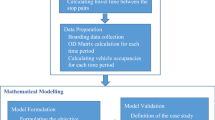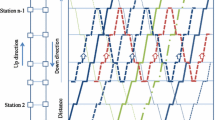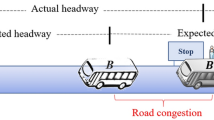Abstract
We develop a short turning model using demand information from station to station within a single bus line-single period setting, aimed at increasing the service frequency on the more loaded sections to deal with spatial concentration of demand considering both operators’ and users’ costs. We find analytical expressions for optimal values of the design variables, namely frequencies (inside and outside the short cycle), capacity of vehicles and the position of the short turn limit stations. These expressions are used to analyze the influence of different parameters in the final solution. The design variables and the corresponding cost components for operators and users (waiting and in-vehicle times) are compared against an optimized normal operation scheme (single frequency). Applications on actual transit corridors exhibiting different demand profiles are conducted, calculating the optimal values for the design variables and the resulting benefits for each case. Results show the typical demand configurations that are better served using a short turn strategy.



Similar content being viewed by others
Notes
Results from changes in attraction of trips are analogous to those from changes in generation, as shown in Tirachini (2007).
This result depends on the fact that the load in the segment after station 1 is lower than after stations 2, 3 and 4 (Fig. 2b). In general, if demands outside the short turning (stations 1–4) were similar, the distance to the short turn would play a role, as the farther a station to a existing short turn is, the higher the operator cost to include that station.
References
Ceder, A., Stern, H.I.: Deficit function bus scheduling with deadheading trip insertion for fleet size reduction. Transp. Sci. 15(4), 338–363 (1981)
Ceder, A.: Optimal design of transit short-turn trips. Transp. Res. Rec. 1221, 8–22 (1989)
Ceder, A.: Public transport timetabling and vehicle scheduling. In: Lam, W., Bell, M. (eds.) Advanced Modeling for Transit Operations and Service Planning, pp. 31–57. Pergamon Imprint, Elsevier Science Ltd. Pub, Amsterdam (2003a)
Ceder, A.: Designing public transport network and route. In: Lam, W., Bell, M. (eds.) Advanced Modeling for Transit Operations and Service Planning, pp. 59–91. Pergamon Imprint, Elsevier Science Ltd. Pub, Amsterdam (2003b)
Ceder, A.: Improved lower-bound fleet size for fixed and variable transit scheduling. 9th International Conference on Computer-Aided Scheduling of Public Transport (CASPT), August 9–11, 2004 San Diego, California, USA (2004)
Delle Site, P.D., Filippi, F.: Service optimization for bus corridors with short-turn strategies and variable vehicle size. Transp. Res. A 32(1), 19–28 (1998)
Eberlein, X.J., Wilson, N.H.M., Barnhart, C., Bernstein, D.: The real-time deadheading problem in transit operations control. Transp. Res. B 32(2), 77–100 (1998)
Eberlein, X.J., Wilson, N.H.M., Bernstein, D.: Modeling real-time control strategies in public transit operations. In: N.H.M. Wilson (Ed.), Computer-Aided Transit Scheduling, Lecture Notes in Economics and Mathematical Systems 471, pp. 325–346, Springer-Verlag, Heidelberg (1999)
Furth, P.: Alternating deadheading in bus route operations. Transp. Sci. 19(1), 13–28 (1985)
Furth, P.: Zonal route design for transit corridors. Transp. Sci. 20(1), 1–12 (1986)
Furth, P.: Short turning on transit routes. Transp. Res. Rec. 1108, 42–52 (1987)
Jansson, J.O.: A simple bus line model for optimization of service frequency and bus size. J. Transp. Econ. Policy 14, 53–80 (1980)
Jara-Díaz, S.R., Gschwender, A.: Towards a general microeconomic model for the operation of public transport. Transp. Rev. 23(4), 453–469 (2003)
Jara-Diaz, S.R., Tirachini, A., Cortés, C.E.: Modeling public transport corridors with aggregate and disaggregate demand. J. Transp. Geogr. 16, 430–435 (2008)
Jordan, W.C., Turnquist, M.A.: Zone scheduling of bus routes to improve service reliability. Transp. Sci. 13(3), 242–268 (1979)
Mohring, H.: Optimization and scale economies in urban bus transportation. Am. Econ. Rev. 62, 591–604 (1972)
Oldfield, R.H., Bly, P.H.: An analytic investigation of optimal bus size. Transp. Res. 22B, 319–337 (1988)
Osuna, E.E., Newell, G.F.: Control strategies for an idealized public transportation system. Transp. Sci. 6, 52–72 (1972)
Tirachini, A.: Estrategias de asignación de flota en un corredor de transporte público. MSc Thesis, Universidad de Chile (2007)
Tirachini, A., Cortés, C.E.: Disaggregated modeling of pre-planned short-turning strategies in transit corridors. CD Proceedings, Transportation Research Board (TRB) 86th Annual Meeting, Washington DC, USA (2007)
Vijayaraghavan, T.A., Anantharmaiah, K.M.: Fleet assignment strategies in urban transportation using express and partial services. Transp. Res. A 29(2), 157–171 (1995)
Welding, P.I.: The instability of a close-interval service. Oper. Res. Q. 8(3), 133–148 (1957)
Acknowledgements
This research was partially financed by grants 1061261 and 1080140 from Fondecyt, Chile, and the Millennium Institute “Complex Engineering Systems” (ICM: P-05-004-F, CONICYT: FBO16).
Author information
Authors and Affiliations
Corresponding author
Appendices
Appendix A. Definition of g i functions
-
g0 is the total running time:
-
g1 and g2 are in the waiting and cycle times, g1 is the demand benefited by the strategy (origin and destination inside the short turn), while g2 are the passenger whose origin or destination are outside the short turn.
-
g3 is the running time for vehicles inside the short turn
-
g4 is the in-vehicle time experienced by passengers
-
g5 and g6 are the factors to calculate the total dwell time of passengers benefited by the strategy and the others, respectively.
where
Appendix B. Load of vehicles between stations
-
1.
Load of vehicles serving the entire corridor (fleet A):
Direction 1
Direction 2
-
2.
Load of vehicles performing short turning (fleet B):
Direction 1
Direction 2
After applying the short-turning strategy, the maximum load will correspond to some segment, which can belong to either direction 1 or 2. However, by observing the recursive form of the load equations above, we can establish the following:
-
If the maximum load occurs along direction 1, then we can say that
-
Otherwise, if the maximum load occur along direction 2, then we can say that
Thus, a generic relation between the design capacity of buses and the frequencies f A and f B can be established in the way summarized in Eq. 14:
where, if the maximum load happens on a segment that belongs to direction 1, then ϑ 0(s 0, s 1) = φ 10 (s 0, s 1) and ϑ 1(s 0, s 1) = φ 11 (s 0, s 1). Otherwise, if the maximum load occurs on a segment that belongs to direction 2, then ϑ 0(s 0, s 1) = φ 20 (s 0, s 1) and ϑ 1(s 0, s 1) = φ 21 (s 0, s 1).
Rights and permissions
About this article
Cite this article
Tirachini, A., Cortés, C.E. & Jara-Díaz, S.R. Optimal design and benefits of a short turning strategy for a bus corridor. Transportation 38, 169–189 (2011). https://doi.org/10.1007/s11116-010-9287-8
Published:
Issue Date:
DOI: https://doi.org/10.1007/s11116-010-9287-8




